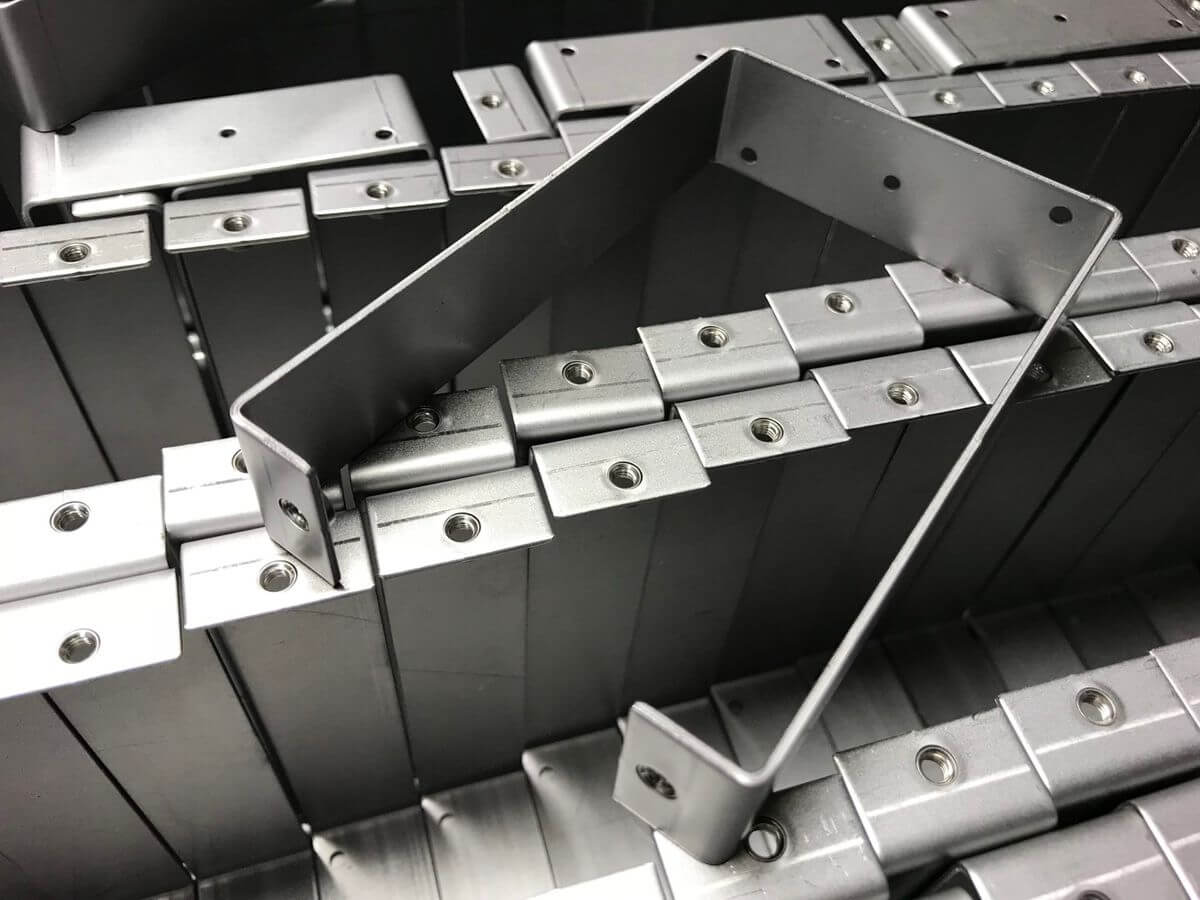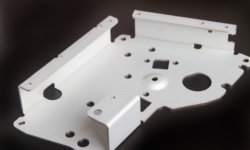What is a bracket? In short, a bracket is an intermediate component used to fix one thing (like a shelf) to another (like a wall). It may be thought of a kind of fastener, but this is somewhat misleading: actual fasteners like screws are used to connect the bracket to the other parts.
In addition to creating a connection between two parts, a bracket may provide support. Some brackets, such as gusset brackets, are designed with a diagonal section that reduces the strain on the bracket and allows it to support heavier loads.
One of the easiest and most cost-effective ways to make brackets, especially simple ones like angle brackets, is sheet metal fabrication. Brackets typically consist of two or more planes connected along one edge, and often to simplest way to fabricate this kind of object is to bend a flat object (i.e. a piece of sheet metal) in two or more places: the simplest example would be adding a 90° bend to a flat rectangle with a straight profile, turning it into a bracket with an L-shaped profile.
But how do you go about creating a sheet metal bracket? 3ERP has years of expertise in sheet metal prototyping, and this guide explains the basics of sheet metal brackets, including common bracket types, bracket design tips, and the best sheet metal bracket materials.
What are brackets and how are brackets used?
Brackets are connecting devices used to join two objects. In architecture, they may be made of wood or stone and used to join walls with features like parapets or eaves. In engineering, however, they are often made of sheet metal and used to support objects like shelving, countertops, flooring, sections of furniture, and mounted televisions.
Although there are many types of brackets, they are most commonly L-shaped, with the vertical section of the bracket attached to a wall (or another large upright structure) and the horizontal section attached to a smaller object being fitted to the wall, such as a shelf.
Brackets often have holes in them, either threaded or unthreaded, so that screws or other fasteners can be fed through them, but this is not a defining feature of the bracket.
Most brackets are functional, with their purpose being to connect and support objects. However, brackets can also be decorative: since brackets are often visible (such as on shelves mounted above eye level) they may have cosmetic features and flourishes, from intricately machined decorative features to gold plating.
How are brackets made?
Brackets can be made in various ways, such as casting or CNC machining. However, the best way to make simple brackets is sheet metal fabrication.
One of the most common sheet metal processes is bending, in which a machine called a brake is used to bend sheet metal to an angle up to 120°. This is perhaps the most important process when making sheet metal brackets, since virtually all brackets incorporate at least one bend.
Other sheet metal processes must also be used. Before any bending takes place, the sheet metal must be cut to size using a machine such as a laser cutter or plasma cutter. A punching machine may be used to make holes in the bracket (for screws), and welding may be required to add gussets or other features.
In addition to sheet metal processes described above, CNC machining may be used to add more complex features to brackets, especially with custom designs for nonstandard components.
Best materials for sheet metal brackets
Brackets can be made from a variety of metals, depending on certain factors, including: the load it must support, cosmetic requirements, surface finishing requirements, minimum and maximum thickness, required bending angles, and budget for manufacturing.
Possible sheet metal bracket materials include:
- Steel
- Stainless steel
- Aluminum
- Brass
Common types of bracket
There are several bracket types that can be made using sheet metal fabrication and other processes. Bracket varieties vary depending on the application and the objects they are designed to support.
L-Bracket
An L-bracket is one of the most common bracket types. As the name suggests, it has an L-shaped profile after being bent along a single axis, usually creating a 90° angle.
L-brackets are used in many applications where a horizontal object (e.g. a shelf) needs mounting to a vertical object (e.g. a wall).
U-Bracket
A U-bracket is another type of bracket. Unlike an L-bracket, a U-bracket is bent along two axes, forming a U-shaped profile.
U-brackets can be used to grip an object between its two flanges, or to mount two parallel horizontal objects one above the other.
Z-Bracket
A Z-bracket is another bracket type that incorporates two bends. However, unlike a U-bracket, in which both bends are made on the same face of the sheet metal, a Z-bracket bends one flange inwards and the other outwards, making a Z-shaped profile.
Z-brackets can be used to mount parallel surfaces that are offset from one another.
Gusset Bracket
A gusset bracket is a type of bracket supported with extra material to improve its strength and load-bearing capacity. It is like an L-bracket but with an extra triangular section of material between the vertical and horizontal sections.
Gussets can either be welded onto the bracket, or included within a single piece: if the latter, the horizontal and vertical faces of the bracket are bent from the edges of the triangle.
Designing sheet metal brackets
Sheet metal brackets can be designed in any good CAD software, but it is important to keep a few things in mind while creating a design.
L-shaped brackets are usually designed with a 90° angle, but manufacturers can create different angles (up to 120°) if instructed to do so. Bear in mind, however, that less ductile metals and thicker gauges are harder to bend and cannot accommodate extreme angles.
While L-brackets are easy to form with a brake, U-brackets and Z-brackets require more preparation. A brake will not be able to make the second bend in a bracket if one flange is long enough to interfere with the brake’s clamping bar. The parallel sections of a U or Z bracket should therefore be as short as possible.
An important feature of metal brackets is the holes for fasteners. While wooden or plastic brackets might simply be drilled through at the point of mounting, metal brackets should have dedicated holes. Decide what size of fastener you will use when designing the bracket, and adjust the diameter of the holes accordingly. Threaded (tapped) holes may be required if a nut cannot be used.
Welded sections can be indicated in the bracket design but will incur additional cost from the manufacturer. Consider whether the part can be made from a single piece of metal before adding welded elements.
Any machined elements, including holes, will incur additional expense, but remember that machining opens up greater design possibilities for nonstandard shapes and decorative touches.
3ERP is a prototyping and low-volume production specialist with expertise in sheet metal and machining. Contact us for a free quote on your next order of brackets.






